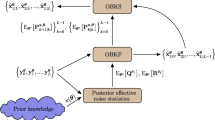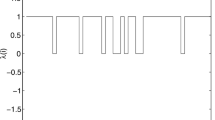Abstract
Motivated by the fact that the a priori least-squares-order-recursive lattice (LSORL) smoother is more robust than the LSORL joint-process estimator with lagged desired signals in the finite precision, we model numerical properties of the two algorithms by virtue of previous efforts. Then, we give the reason why the smoother is substantially more robust than the lagged joint-process estimator by providing the explicit analysis for the performance difference of the two algorithms.







Similar content being viewed by others
References
Einicke GA (2006) Optimal and robust noncausal filter formulations. IEEE Trans Signal Process 54(3):1069–1077
Zhao Q, Tong L (1999) Adaptive blind channel estimation by least squares smoothing. IEEE Trans Signal Process 47(11):3000–3012
Nawrocka A, Kot A (2011) Methods for EEG signal analysis. In: Proc. 12th inter journ Carpathian control conf, Velke Karlovice, Czech Rep, pp 266–269
Xun C, Wang ZJ (2011) Design and implementation of a wearable, wireless EEG recording system. In: 5th inter conf on bioinformatics and biomedical engineering, Wuhan, China, pp 1–4
Tarvainen MP, Hiltunen JK, Ranta-aho PO, Karjalainen PA (2004) Estimation of nonstationary EEG with Kalman smoother approach: an application to event-related synchronization (ERS). IEEE Trans Biomed Eng 51(3):516–524
Lee DT, Morf M, Friedlander B (1981) Recursive least squares LSORL estimation algorithms. IEEE Trans Circuits Syst CAS-28(6):467–481
Morf M, Vieira A, Lee DT (1977) Ladder forms for identification and speech processing. In: Proc IEEE conf decision contr, New Orleans, LA, pp 1074–1078
Reddy VU, Egardt B, Kailath T (1981) Optimized lattice-form adaptive line enhancer for a sinusoidal signal in broad-band noise. IEEE Trans Acoust Speech Signal Process 29:702–710
Satorius EH, Pack JD (1981) Application of least squares lattice algorithms to adaptive equalization. IEEE Trans Commun 136–142
Clement MJ, Judd GM, Morse BS, Flanagan JK (1999) Performance surface prediction for WAN-based clusters. J Supercomput 13(3):267–281
Mathews VJ, Xie Z (1990) Fixed-point error analysis of stochastic gradient adaptive lattice filters. IEEE Trans Acoust Speech Signal Proces 38
North R, Zeidler J, Ku W, Albert T (1993) A floating-point arithmetic error analysis of direct and indirect coefficient updating techniques for adaptive lattice filters. IEEE Trans Signal Process 41:1809–1823
Ling F (1989) Efficient least-squares lattice algorithms based on givens rotation with systolic array implementations. In: Proc. ICASSP, Glasgow, Scotland, pp 1290–1293
Yang B (1994) A note on the error propagation analysis of recursive least squares algorithms. IEEE Trans Signal Process 42:3523–3525
Levin MD, Cowan CFN The performance of eight recursive least squares adaptive filtering algorithms in a limited precision environment. In: Proc. European signal process conf, Edinburgh, Scotland pp 1261–1264
Bunch JR, LeBorne RC (1995) Error accumulation effects for the a posteriori RLSLS prediction filter. IEEE Trans Signal Process 43(1):150–159
Yuan JT, Stuller JA (1995) Least squares order recursive lattice smoothers. IEEE Trans Signal Process 43:1058–1067
Kim DK, Park PG (2002) The normalized least squares order-recursive lattice smoothers. Signal Process 82:895–905
Haykin S (1996) Adaptive filter theory, 3rd edn. Prentice-Hall, Englewood Cliffs
Godana B, Ekman T (2011) Linear prediction of time-varying MIMO systems using Givens rotations. In: Proc. SPAWC, San Francisco, CA, pp 317–375
Proakis JG (1995) Digital communications, 3rd edn. McGraw-Hill, New York
Chen F, Kwong S, Kok CW (2009) Blind MMSE equalization of FIR/IIR channels using oversampling and multichannel linear prediction. ETRI J 31(2):162–172
Acknowledgement
This work was supported by MKE/DDI [A2010D-D0004, Development of Green P2mP Wireless Backhaul System]
Author information
Authors and Affiliations
Corresponding author
Rights and permissions
About this article
Cite this article
Lee, Y.S., Kim, D.K. & Barolli, L. Network numerical analysis for the smoother and the lagged joint-process estimator. J Supercomput 65, 1192–1204 (2013). https://doi.org/10.1007/s11227-012-0753-2
Published:
Issue Date:
DOI: https://doi.org/10.1007/s11227-012-0753-2




